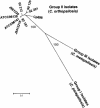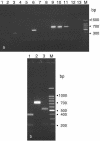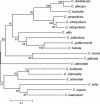Candida orthopsilosis and Candida metapsilosis spp. nov. to replace Candida parapsilosis groups II and III
- PMID: 15634984
- PMCID: PMC540126
- DOI: 10.1128/JCM.43.1.284-292.2005
Candida orthopsilosis and Candida metapsilosis spp. nov. to replace Candida parapsilosis groups II and III
Abstract
Two new species, Candida orthopsilosis and C. metapsilosis, are proposed to replace the existing designations of C. parapsilosis groups II and III, respectively. The species C. parapsilosis is retained for group I isolates. Attempts to construct a multilocus sequence typing scheme to differentiate individual strains of C. parapsilosis instead revealed fixed DNA sequence differences between pairs of subgroups in four genes: COX3, L1A1, SADH, and SYA1. PCR amplicons for sequencing were obtained for these four plus a further seven genes from 21 group I isolates. For nine group II isolates, PCR products were obtained from only 5 of the 11 genes, and for two group III isolates PCR products were obtained from a different set of 5 genes. Three of the PCR products from group II and III isolates differed in size from the group I products. Cluster analysis of sequence polymorphisms from COX3, SADH, and SYA1, which were common to the three groups, consistently separated the isolates into three distinct sets. All of these differences, together with DNA sequence similarities <90% in the ITS1 sequence, suggest the subgroups should be afforded species status. The near absence of DNA sequence variability among isolates of C. parapsilosis and relatively high levels of sequence variability among isolates of C. orthopsilosis suggest that the former species may have evolved very recently from the latter.
Figures




References
-
- Ashford, B. K. 1928. Certain conditions of the gastrointestinal tract in Puerto Rico and their relation to tropical sprue. Am. J. Trop. Med. Hyg. 8:507-538.
-
- Cassone, A., F. De Bernardis, E. Pontieri, G. Carruba, C. Girmenia, P. Martino, M. Fernandez-Rodriguez, G. Quindos, and J. Ponton. 1995. Biotype diversity of Candida parapsilosis and its relationship to the clinical source and experimental pathogenicity. J. Infect. Dis. 171:967-975. - PubMed
-
- Clark, T. A., J. Morgan, M. Brandt, T. Lott, S. Slavinski, S. Taylor, H. Flowers, S. Fridkin, and R. Hajjeh. 2002. Hospital outbreak of Candida parapsilosis bloodstream infections-Mississippi, 2001. Program Abstr. 42nd Intersci. Conf. Antimicrob. Agents Chemother., abstr. M-880.
Publication types
MeSH terms
Substances
Associated data
- Actions
- Actions
- Actions
- Actions
- Actions
- Actions
- Actions
- Actions
- Actions
- Actions
- Actions
- Actions
Grants and funding
LinkOut - more resources
Full Text Sources
Miscellaneous

